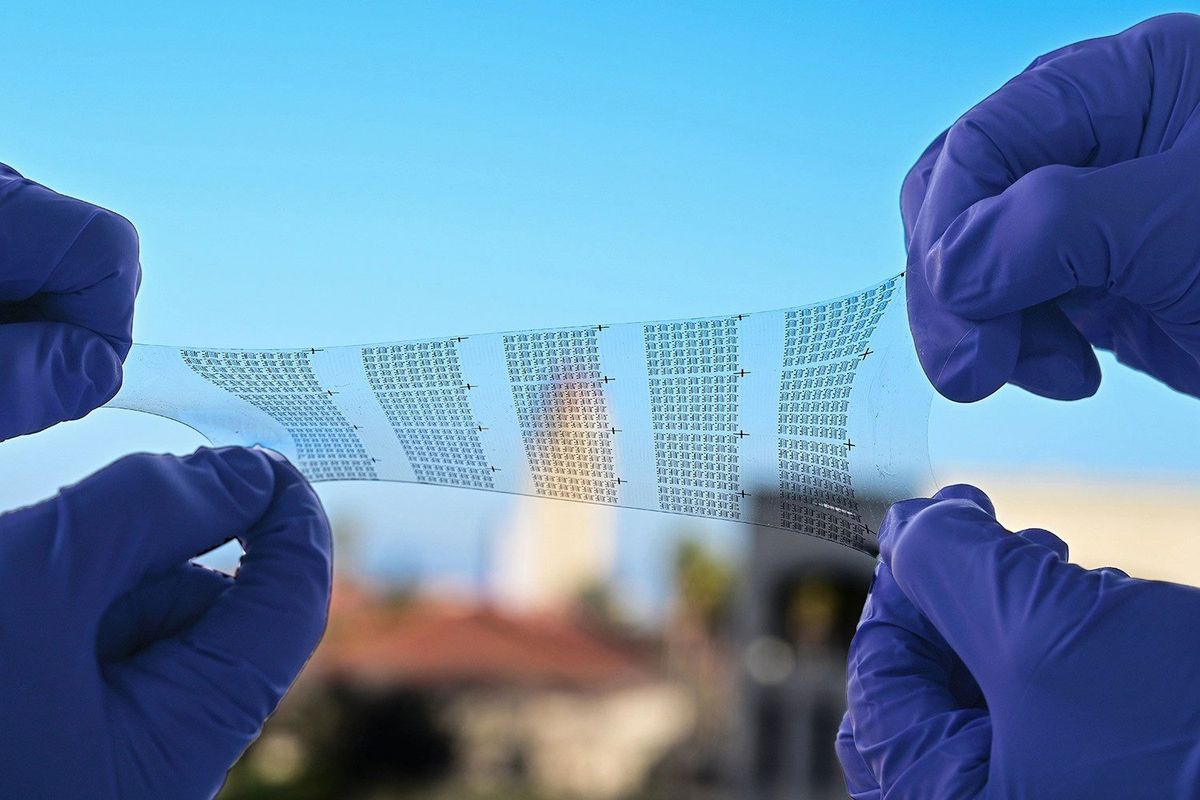
Newly developed intrinsically stretchable circuits are thousands of times as fast as and possess 20 times as many transistors as previous intrinsically stretchable electronics. The researchers at Stanford University who developed the circuits have already demonstrated their use in a skin-like Braille-reading sensor array that they say is more sensitive than a human fingertip.
In general, flexible electronics have potential for any application requiring interactions with soft materials, such as devices worn on or implanted within the body. Those applications could include on-skin computers, soft robotics, and brain-machine interfaces.
However, conventional electronics are made of rigid materials such as silicon and metal. Placing electronic components on plastic films can make them flexible enough to bend; however, the extent to which such devices can stretch is typically just about 1 percent of their normal size, says Zhenan Bao, a professor of chemical engineering at Stanford University.
Previous research has explored how to create electronics from intrinsically stretchable materials such as carbon nanotubes and silver nanowires. But until now stretchable electronics have shown dismal performance.
Bao and her colleagues have now developed intrinsically stretchable transistors and circuits that have set multiple new records. They published their findings on 13 March in the journal Nature.
“Stretchable sensor arrays can be incorporated into prosthetic limbs and orthopedic devices to provide feedback on pressure distribution, muscle activity, and joint movements.” —Zhenan Bao, Stanford University
The new devices feature high-purity semiconducting carbon nanotube channels, metallic palladium-coated carbon nanotube electrodes, and high-conductivity stretchable gallium-indium alloy interconnects. A major goal of the design was to reduce factors such as parasitic capacitance and interconnect resistance that limit transistor speed.
The researchers fabricated an integrated circuit about 28 square millimeters in size that possesses 1,056 transistors, 528 logic gates, and an operating speed of more than 1 megahertz. Previous intrinsically stretchable electronics were at best capable of 54 transistors and 14 logic gates per circuit, and operating speeds of only 330 hertz.
In addition, the new stretchable transistors demonstrated a field-effect mobility—the speed at which charge flows in a device, which helps control transistor switching speed—of more than 20 square centimeters per volt per second on average, even when stretched to twice their normal size. This results in electrical performance about 20 times as good as previous stretchable electronics, the researchers say.
The transistors also displayed a drive current—which also influences transistor switching speed—of about 2 milliamps per micron, given a supply voltage of 5 volts. This is more than 40 times better than prior stretchable devices. All in all, these new transistors perform roughly as well as state-of-the-art flexible transistors that combine carbon nanotubes, metal oxides, or polycrystalline silicon with plastic films.
To demonstrate a practical application for the new electronics, the researchers built an 8-square-millimeter tactile sensor array that could stick onto a human finger and read Braille writing. The array’s pixels are each just 200 microns wide and arranged in a 10 by 20 pixel grid. In other words, the array posses 2,500 sensors per square centimeter, which is more than 10 times the density of a human fingertip’s mechanical receptors.
The array’s dense configuration of sensors makes it possible to recognize shapes such as triangles, circles, and rectangles less than 1 millimeter across. “Stretchable sensor arrays can be incorporated into prosthetic limbs and orthopedic devices to provide feedback on pressure distribution, muscle activity, and joint movements,” Bao says. “Stretchable sensor arrays can also be used in human-machine interfaces for gesture recognition and motion tracking.”
The new electronics could also help drive an LED array with a refresh rate of more than 60 Hz, which is typical of a computer or TV screen. Even when twisted or stretched, the transistor array could still display numbers, letters, and symbols. One possible application this would enable are stretchable displays for wearable devices that “can conform to the contours of the body, providing users with real-time information and notifications while maintaining comfort without constraining daily life,” Bao says.
The new circuits are made with materials and processes that can work with existing fabrication methods. Bao notes that industry manufacturers cannot make the new circuits without some additional fine-tuning of their fabrication processes, but the tools are already in place.
One future direction for research is to find better ways of packaging the electronics. This will help enable stable operation and long life, Bao says.
Source: IEEE Semiconductors
